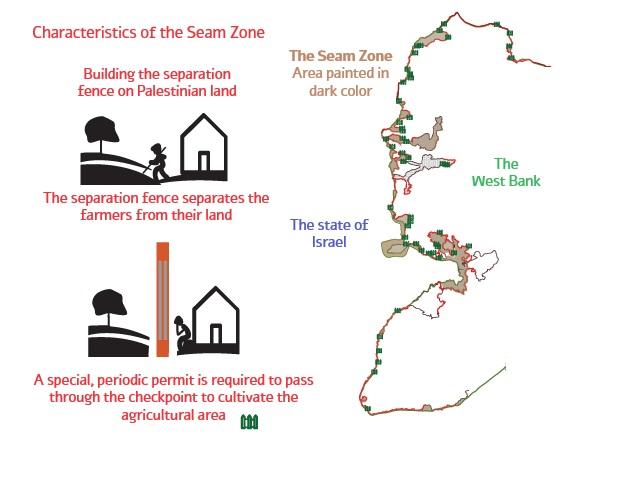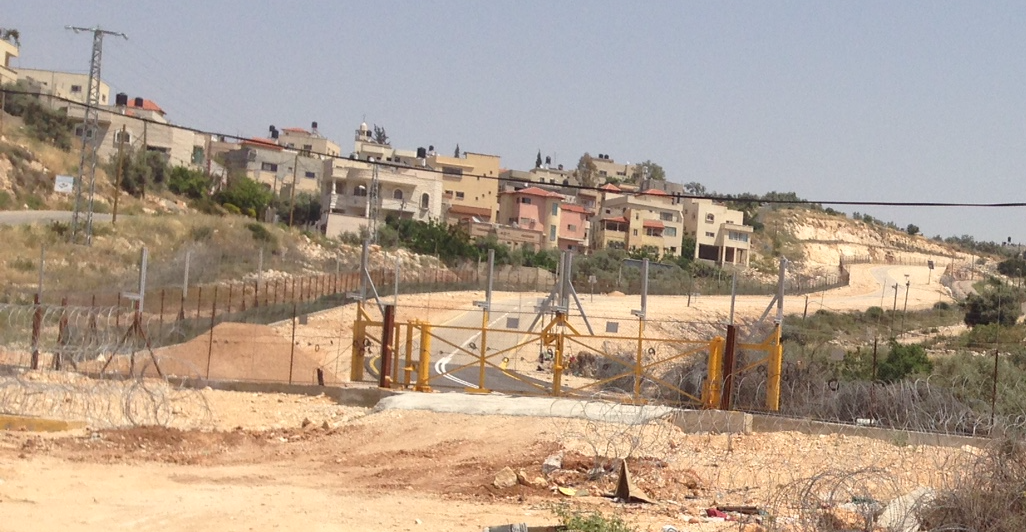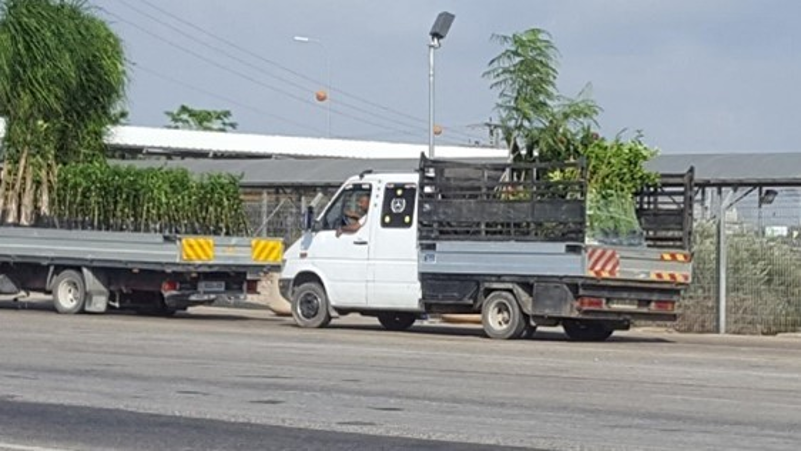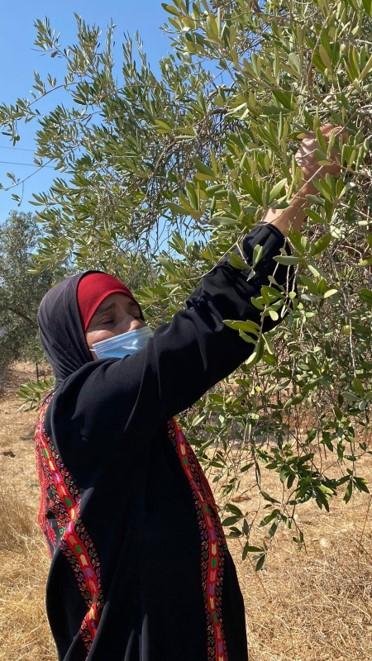
After the Second Intifada broke out in 2000, Israel decided to prevent passage between the West Bank and Israel which had been free for over 30 years, by putting up a separation barrier (electronic fence and wall with patrol roads). Its route did not adhere to the ‘green line’ but rather wound its way in many places and penetrated the West Bank in order to leave as many settler colonies as possible inside Israel, as well as large areas for their expansion.
The area caged between the fence and the ‘green line’ is named the seam zone. It contains the enclaves of Jewish settlements that are near the ‘green line’ (such as Alfei Menashe and Elkana), about 12 Palestinian villages disconnected from the West Bank by the fence, and vast farmlands belonging to Palestinian villages and disconnected from them by the fence. In total, the seam zone contains about 140,000 dunams of Palestinian farmlands, constituting about 12% of all the potential farmland in the West Bank.
Palestinians are not allowed to enter the entire seam zone without a permit, although it is an occupied area that has not been annexed to Israel, whereas Israelis and even tourists may move in it freely.


At the agricultural checkpoint Habla we meet the children of Arab A-Ramadin village and their school teachers, going through an inspection on their transport to school at nearby Habla beyond the fence. Also inspected are the women who must return from their work in the West Bank through the checkpoint, and search for transport to their isolated villages.
According to UN data, at present (2020) there are 11,000 Palestinians living in villages of the seam zone enclaves, which the fence has disconnected from the West bank. In these isolated villages – such as Arab A-Ramadin on the way to the Israeli settlement Alfei Menashe, Umm Al-Reihan in the northern West Bank, or Nabi Samauil near Jerusalem – the villagers’ lives are unbearable. They must hold permits to live in their own homes, and little children must carry their original birth certificate in order to get home from school.
In order to reach the neighboring village or nearby town (east of the fence) to school, to work, and any other life need, they must have permits and cross checkpoints on their way to and fro. Their families and friends, living in the West Bank, may not ever visit them. The absurdity is that from these villages they could reach anywhere inside Israel without crossing any checkpoint whatsoever, but as holders of Palestinian IDs, they may not be inside Israel without a permit…
No doubt the tearing of these villagers from their immediate environment has harshly impacted all aspects of life – economy, education, health, and family and social fiber.
Can I go out of here?
A village in a transparent cageThe State of Israel recognizes Palestinian farmers’ claim to their land in the seam zone and behind the separation barrier. The military system committed itself in the Supreme Court not to hurt the livelihood of the farmers in any ‘disproportionate’ manner, and enable them to access their land, tend it and enjoy its crops and keep their bond to their land.
The state also determined what the Palestinian may grow in every area, what kind of farm work was needed for that purpose and how often. That is why the ‘agricultural gates ’ were installed along the fence. From the start, the gates erected in the fence were distant from one another and from farm tracks, and sometimes access to them with tractors was difficult or even impossible. And then the gates turned into checkpoints.
’ were installed along the fence. From the start, the gates erected in the fence were distant from one another and from farm tracks, and sometimes access to them with tractors was difficult or even impossible. And then the gates turned into checkpoints.
Of the 76 gates opened for farming needs along the hundreds of kilometers of the fence, only about 26 are active all year round, and even they are closed most of the day. Half of the 26 are active all days of the week, the rest only 2-3 times a week. All these are opened and locked by soldiers for very short periods of time, about 15 minutes, and are subject to tardiness and a long wait for the soldiers to arrive.
As for the 50 remaining gates - about half of them do not open at all, and others, called "seasonal gates", are closed most days of the year. Also, Receiving the permit to pass over to fields the materials and tools necessary for their tending requires a long and exhausting negotiation with the Civil Administration
.
The gates/checkpoints have not made things easier for the farmers and did not prevent the ruin of farming in the area. Instead of accessing his lands by the shortest way possible, unlimited in time and with the workers and equipment he needs for his work, the farmer found himself facing a new situation: He may not enter his own grounds unless he holds a special permit, for better through a distant gate opened 2-3 times a day for short periods of time. A farmer entering his area in the morning to work a few hours or even just to turn on his irrigation system must remain there for hours, even the whole day – if the checkpoint is opened again only at noon or in the evening accordingly. Under such conditions, very few farmers have installed irrigation systems in their fields in the seam zone, and the possibility to have efficient farming in the whole area is denied. This impacts the livelihood of about Palestinian 200,000 inhabitants.
In recent years we have been following areas that were returned to Palestinians in the villages of Jayous, Falamiya, and Kafr Jamal when the separation fence was moved westward following a Supreme Court ruling. From nearly desolate land except for some abandoned olive trees, the land became a flourishing and fruitful garden, with fields orderly and surrounded by stone fences to protect them from wild boars, as well as a well-planned irrigation system that enables the owners to grow various crops.
About the olive harvest and the "Seasonal gates/checkpoints"







